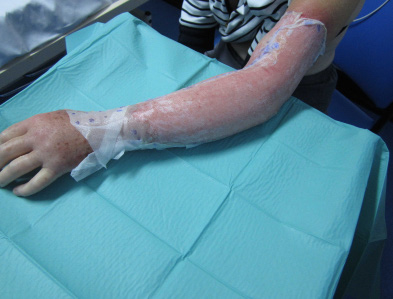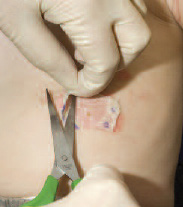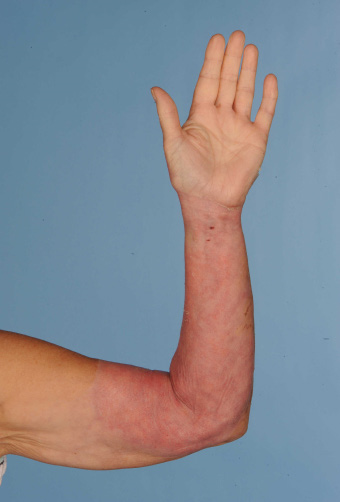Cervical nerve root injection (block)
Your doctor has requested that you have a cervical nerve root block. We hope the following information will answer some of the questions you may have about this procedure.
What is a cervical nerve root block?
Cervical nerve roots leave the spinal cord in the neck and become nerves that travel down your arm. Nerve roots can become irritated or inflamed as they leave the spine due to disc bulges, thickening of ligaments and also new bone formation. Inflammation of the cervical nerve roots may cause pain in the neck and/or arm. A cervical nerve root block may provide some pain relief, but more importantly it may provide diagnostic information for your doctor. The procedure is designed to find out if a nerve is causing your pain by placing temporary numbing medicine in and around the nerve root in question.
Why do I need to have a cervical nerve root block?
If the pain improves following the injection, this suggests that the nerve is the most likely cause of the pain. On the other hand, if there is no improvement following, this tends to suggest that there may be an alternative source of pain. The doctor in charge of your case feels this is an appropriate procedure for you, to help to diagnose the cause of your pain. However you will have the opportunity for your opinion to be taken into account; if you do not want the procedure carried out then you can decide against it.
How do I prepare for a nerve root block?
There is no preparation for this procedure; you can continue to eat and drink as normal.
If you are diabetic please inform the doctor before the examination as there is a possibility that your sugar levels will vary after the injection. It is important that you continue to monitor your levels carefully for three days after the procedure and consult your GP if necessary.
If you are taking any blood thinning tablets which include anti-platelets, for example: aspirin, clopidogrel or anti-coagulants, for example: warfarin, dabigatran, rivaroxaban and apixaban please contact the department before the appointment on 0117 414 9008, as you may need to consult your GP before undergoing this test. Please do not stop any medication until you have spoken to us.
Please make arrangements for someone to collect you from the hospital and take you home by car, as we advise not to use public transport or drive for 24 hours afterwards.
What are the risks associated with a cervical nerve root block?
Generally it is a very safe procedure. Potential complications are uncommon and include:
- There are many blood vessels in the neck. If one is inadvertently punctured, the procedure will be abandoned and a new appointment will be made for another attempt.
- The injection may not provide any relief of your symptoms. Patients are often disappointed if there is no pain relief, but the information that is gained can still be very helpful. Unfortunately, you won’t know until after the procedure whether it has helped or not.
- Temporary worsening of pain. There is less than 0.4% risk of this occurring (4 in a thousand people).
- Bleeding or haematoma (a bruise under the skin): this should settle down by itself.
- Infection – contact your GP if you experience any redness or tenderness at the injection site.
- An allergic reaction – please inform the doctor if you have any allergies. There is less than 0.2% risk of this occurring (2 in a thousand people).
- Lowering in blood pressure (with light-headedness and nausea). There is approximately a 2.5% risk of this occurring (less than 3 in a hundred).
- Disturbance of the menstrual pattern for some female patients.
The procedure uses x-rays to confirm that the needle is in the correct place. The amount of radiation used is small, however female patients who are or who may be pregnant should inform the department before attending the appointment.
On the day of the procedure:
- You will arrive at Gate 19 and a member of the radiology team will take you through to one of the X-ray rooms.
- You may take your normal medication unless instructed otherwise.
- Please inform us if you are allergic to anything.
- You may be asked to change into a gown or if you prefer you can remain in your own clothes.
- The Consultant Radiologist will talk to you before the procedure to confirm you have read this leaflet and understand it. He/she will explain the procedure and answer any questions you have.
- You will be asked to sign a consent form if you wish to proceed.
- A nurse will take some basic observations, including blood pressure, pulse and oxygen levels. They will also ask some questions about your health, including your current medication. Please bring a list of your current medication with you.
- You will then be asked to lie on the x-ray table. It is important that you are comfortable as you will need to stay in that position for about 20 minutes.
- Most staff will leave the x-ray room whilst preliminary scans are performed. The Radiologist, a radiographer and a nurse will spend the rest of the procedure in the room with you.
- Your skin will be cleaned with an antiseptic solution and covered with sterile drapes.
The Radiologist will then anaesthetise the skin which may sting before the area goes numb. - The Radiologist will direct a fine needle towards the specific nerve in several steps. Between each step another scan will be done to check the position of the needle.
- Once in the correct position the steroid will be injected.
- Your neck will be cleaned again and a plaster will be placed over the injection site.
What happens after the procedure?
- The nurse may repeat basic observations – i.e. blood pressure.
- You will be asked to stay in the department for up to 30 minutes after the procedure has finished.
- You will be able to eat and drink as normal.
- If everything is satisfactory, you will be free to go home. Please arrange for someone to collect you as you are not permitted to drive for 24hours, and we advise you not to use public transport.
- You should rest for the remainder of that day and the following day, avoiding any strenuous activities.
- You may feel weakness and/or numbness in your arms, neck, chest wall or legs. This may develop an hour or so after the procedure and last for several hours. This is quite common.
- The dressing/plaster can be removed after 24 hours.
- If you have any discomfort please take your usual pain relief, as prescribed.
What happens next?
- You will be asked to fill in a pain diary for the next month. This is so that the doctors can read the diary to find out whether the injection has had any effect and for how long.
- The Consultant Radiologist will send a report to your referring doctor who will contact you for follow up.
- If you experience any symptoms you are concerned about, please contact the radiology department directly on the phone number on your appointment letter or alternatively contact your GP or the emergency department.
Finally we hope this information is helpful. If you have any questions either before or after the procedure the staff in the Imaging department will be happy to answer them.
The telephone number for the Imaging department can be found on the appointment letter.
If you or the individual you are caring for need support reading this information please ask a member of staff for advice.
© North Bristol NHS Trust. This edition published December 2023. Review due December 2026. NBT003222







